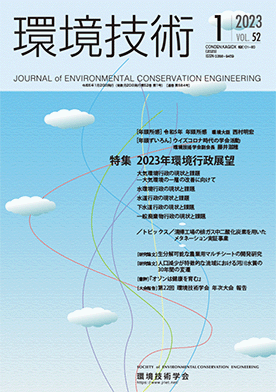
- Issue 6 Pages 296-
- Issue 4 Pages 210-
- Issue 3 Pages 153-
- Issue 2 Pages 59-
- Issue 1 Pages 5-
- |<
- <
- 1
- >
- >|
-
Shizuko OTA2023 Volume 52 Issue 1 Pages 5-9
Published: January 20, 2023
Released on J-STAGE: January 25, 2024
JOURNAL FREE ACCESSDownload PDF (853K) -
Michihiro OI2023 Volume 52 Issue 1 Pages 10-14
Published: January 20, 2023
Released on J-STAGE: January 25, 2024
JOURNAL FREE ACCESSDownload PDF (847K) -
Yoshio NAKURA2023 Volume 52 Issue 1 Pages 15-19
Published: January 20, 2023
Released on J-STAGE: January 25, 2024
JOURNAL FREE ACCESSDownload PDF (1029K) -
Takeshi SUZUKI2023 Volume 52 Issue 1 Pages 20-24
Published: January 20, 2023
Released on J-STAGE: January 25, 2024
JOURNAL FREE ACCESSDownload PDF (905K) -
Seiji TSUTSUI2023 Volume 52 Issue 1 Pages 25-29
Published: January 20, 2023
Released on J-STAGE: January 25, 2024
JOURNAL FREE ACCESSDownload PDF (860K)
-
Shunhao XU, Xiulun WANGArticle type: research-article
2023 Volume 52 Issue 1 Pages 34-40
Published: January 20, 2023
Released on J-STAGE: February 15, 2023
JOURNAL FREE ACCESSThis research typically aims to develop biodegradable mulching sheets for sustainable agriculture using soybean residues, one of the unused herbaceous biomasses. The mulching sheets were efficiently produced by the making process proposed in this research, and their mechanical properties were evaluated. It was produced under 10 different pressure loads during the forming process at 110℃ for 30 minutes. As a result, it can be produced successfully under all the experimental conditions. From the strength test, the tensile rupture stress of mulching sheets increased with the increase in density, and it was in the range of 1.56~9.83 MPa. In addition, the light shielding ratio of the mulching sheets was in the range of 99.76~99.95%. It showed the sheets had sufficient light shielding performance. The forming of mulching sheets was naturally obtained by the hydrogen bond between the fibers without using any chemicals or adhesives.
Therefore, the mulching sheet is fully biodegradable, and could reliably be used as a substitute material for polyethylene agricultural mulching film.
View full abstractDownload PDF (990K) -
Ikuo TAKEDAArticle type: research-article
2023 Volume 52 Issue 1 Pages 41-49
Published: January 20, 2023
Released on J-STAGE: February 15, 2023
JOURNAL FREE ACCESSA long-term investigation on river water quality (nitrogen, phosphorus, and organic matter) in a watershed characterized by population decline was conducted for 30 years since 1991 with weekly intervals. During the survey period, the population and arable land were uniformly decreasing, with the population decreasing by about 25% and the arable land by about half, indicating a clear decrease in human activities that cause water pollution. However, the water quality for the entire survey period did not show any visible downward trend; nitrogen increased in the first half of the period and decreased afterward, and the decreasing trend in phosphorus was limited to middle stream point after 2010. A possible factor explaining the change in nitrogen is thought to be the amount of nitrogen deposition from the atmosphere that increased and decreased in the corresponding period. Regarding the phosphorus decrease, it is thought that a dam that started storing water in 2010 and where a water bloom has been observed since 2014, temporarily blocked the phosphorus flow in the river.
View full abstractDownload PDF (1325K)
- |<
- <
- 1
- >
- >|